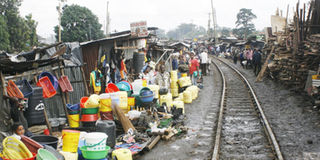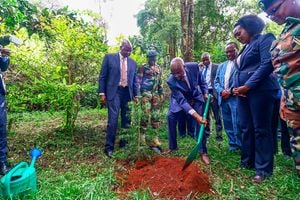5,000 to be moved from railways land

JENNIFER MUIRURI | NATION
The Kenya Railways plans to upgrade its commuter services within and around Nairobi and these Kibera dwellers who have encroached on the railway land will be moved to pave the way for the expansion.
The Kenya Railways Corporation has secured $11 million (Sh880 million) funding to move squatters who have encroached on its land in Nairobi.
Up to 5,000 households living on the railway reserve land in Kibera will be affected by the World Bank-funded movement, which is expected to start in June next year.
Studies along the railway corridor in the expansive slum have also established that 4,500 commercial and institutional structures will be affected by the project.
Encroachment on the corporation’s rail way reserve is the greatest impediment to the project to improve the urban railway system in Nairobi, Kenya Railways managing director Nduva Muli told the Nation on Wednesday.
The railway’s reserve land is 100 feet (or 30 metres) on either side of the tracks.
Trains currently move at a maximum of 20 kilometres per hour through the slum and would need to move at an average of 70-90 kilometres per hour to efficiently transport commuters in the city.
The most affected area is along the seven villages that form Kibera slum, each of which touches the railway, and which has affected the operations of the concessionaire.
“Rift Valley Railways have to pull half of their freight to Kibera station because there is too much slippage on the tracks because a lot of waste is dumped there,” Mr Muli told a gathering of the Institution of Engineers of Kenya on Tuesday evening.
The first phase of the project will involve the acquisition of land for the squatters living in the Mukuru slums on the eastern side of the Nairobi railway.
Building of second line
There are three phases of the Relocation Action Plan by the corporation and the World Bank, and the final cost has been put at $33 million (Sh2.64 billion).
This will make way for the first part of the improvement project, the building of a second line to the Jomo Kenyatta International Airport.
It became necessary to buy land for the Mukuru squatters because there is no other land on which they can be transferred.
For the Kibera project, the plan is to build high-rise residential houses for the squatters and a wall along the length of the reserve boundary, said Mr Muli.




